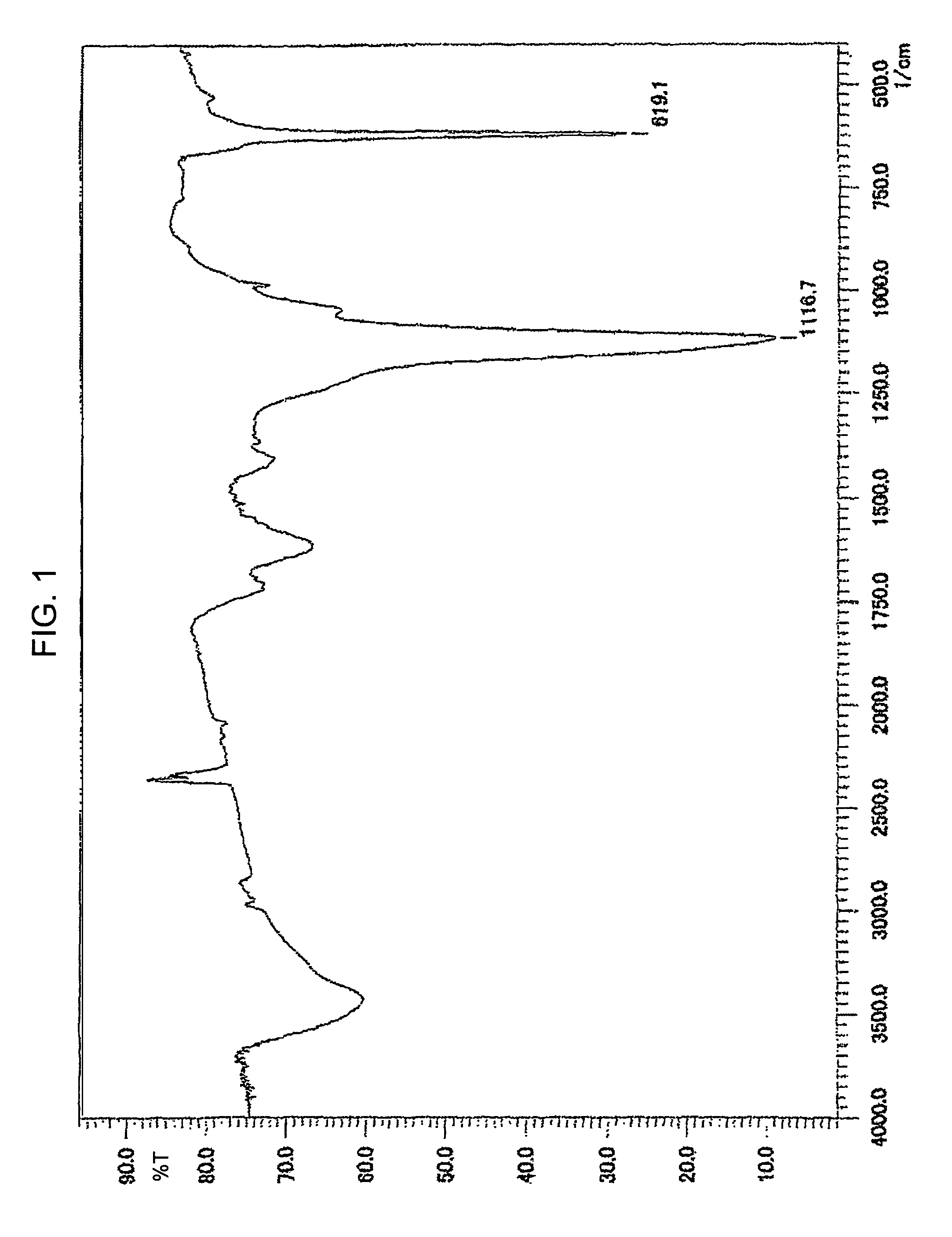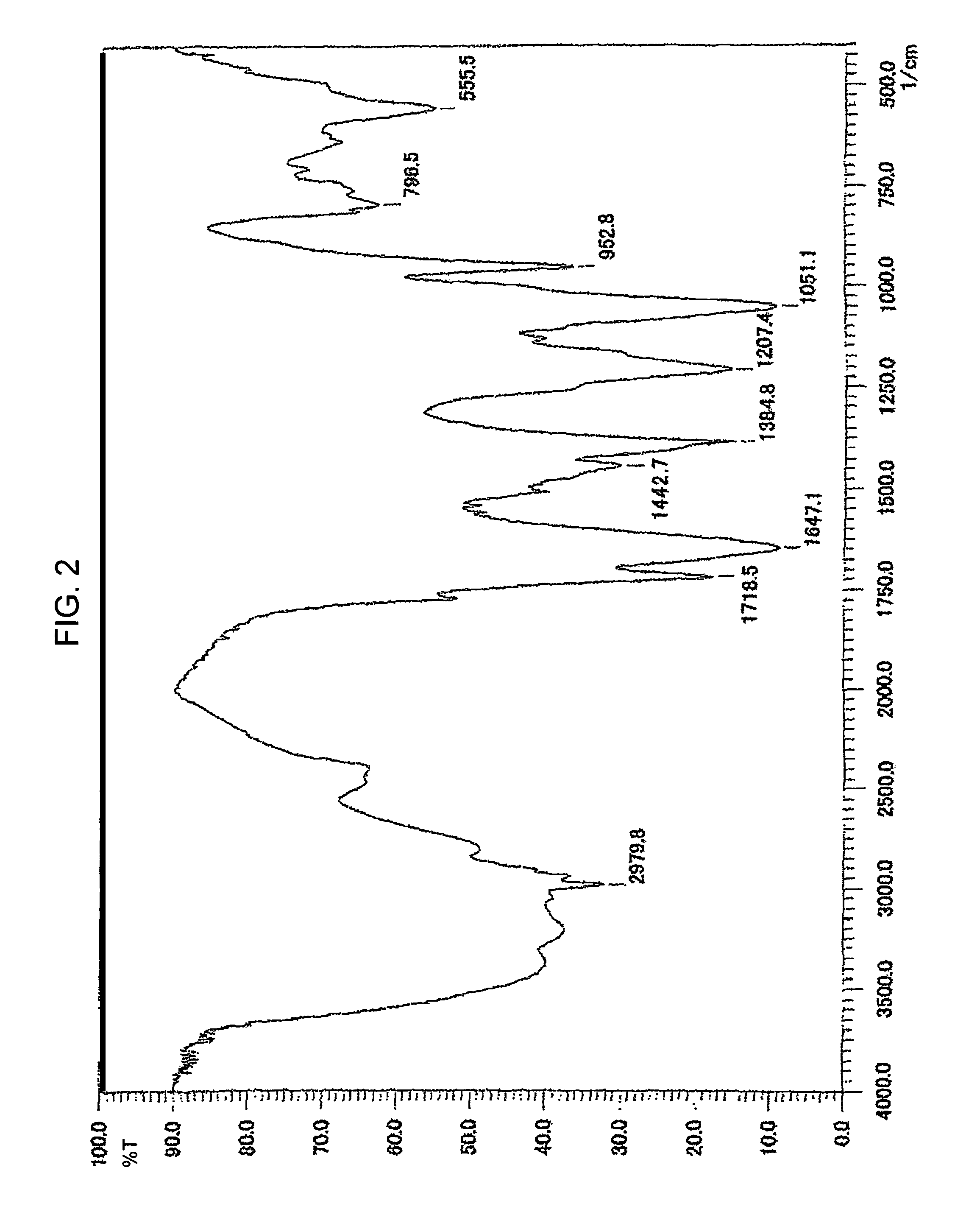Chemically modified fullerene, production method for the same, and proton conducting membrane including the same
a technology of fullerene and production method, which is applied in the field of chemically modified fullerene, can solve the problems of complex production system, deterioration of membrane performance, and inability to obtain target substances, so as to prevent desulfonation reaction and facilitate the supply of desired water-insolubility
- Summary
- Abstract
- Description
- Claims
- Application Information
AI Technical Summary
Benefits of technology
Problems solved by technology
Method used
Image
Examples
first example
[0037]720 mg fullerene C60 and 200 ml dimethylacetamide are put into a 300 ml three-necked flask. 790 mg potassium sulfite K2SO3 (five times that of fullerene in moles) is dissolved into 10 ml water and then added into the flask. Afterwards, the resulting solution is heated and stirred for four days at 80 degrees Celsius. Once the reaction is complete, the solvent is dried and removed, and the residue is extracted using ethanol. Solids are filtered out, and ethanol is then dried and removed from the filtrate. Afterwards, the infrared absorption spectrum is measured using KBr. The measurement shows a peak at 1117 cm−1 representing SO2 stretching and peak at 619 cm−1 representing CS stretching (See FIG. 1). Further, S and K analysis is conducted using inductively coupled plasma atomic emission spectroscopy (ICP-AES), and element analysis of C, H, and O is conducted using a combustion method. These analyses show C: 57.5%, S: 11.4%, K: 14.7%, H: 0.55%, and 0: 13.0% indicating that four ...
second example
[0039]690 mg diethyl phosphate HPO(OEt)2 and 200 ml dioxane are put into a 300 ml three-necked flask, and then 40 mg LiH is added thereto. It is then heated and stirred at 80 degrees Celsius, resulting in generation of H2. Shortly thereafter, the solution becomes transparent. At this time, 720 mg fullerene C60 is added thereto, and the resulting solution is heated and stirred for four days at 80 degrees Celsius. After the reaction is completed, the solvent is dried and removed. The residue is then extracted using ethanol plus THF, and solids are filtered out. The ethanol plus THF is then dried and removed from the resulting filtrate. Afterwards, the infrared absorption spectrum is measured using KBr, showing absorption of C2H5 at 2926 cm−1, absorption of P═O at 1209 cm−1, and absorption of P—O—C at 1043 cm−1, which has proved that phosphonic ester group PO(OEt)2 is bonded. 1 g trimethylsilyl bromide is added to this 500 mg phosphonated fullerene, and transesterification is conducted...
third example
[0040]The same processing as that of the second example is conducted using the sulfonated fullerene provided in the first example as a raw material. As a result, absorption peaks of a sulfonic acid group and a phosphonic acid group appear in the infrared absorption spectrum indicating the coexistence of them.
PUM
| Property | Measurement | Unit |
|---|---|---|
| time | aaaaa | aaaaa |
| chemical | aaaaa | aaaaa |
| partial structure | aaaaa | aaaaa |
Abstract
Description
Claims
Application Information
 Login to View More
Login to View More - R&D
- Intellectual Property
- Life Sciences
- Materials
- Tech Scout
- Unparalleled Data Quality
- Higher Quality Content
- 60% Fewer Hallucinations
Browse by: Latest US Patents, China's latest patents, Technical Efficacy Thesaurus, Application Domain, Technology Topic, Popular Technical Reports.
© 2025 PatSnap. All rights reserved.Legal|Privacy policy|Modern Slavery Act Transparency Statement|Sitemap|About US| Contact US: help@patsnap.com



